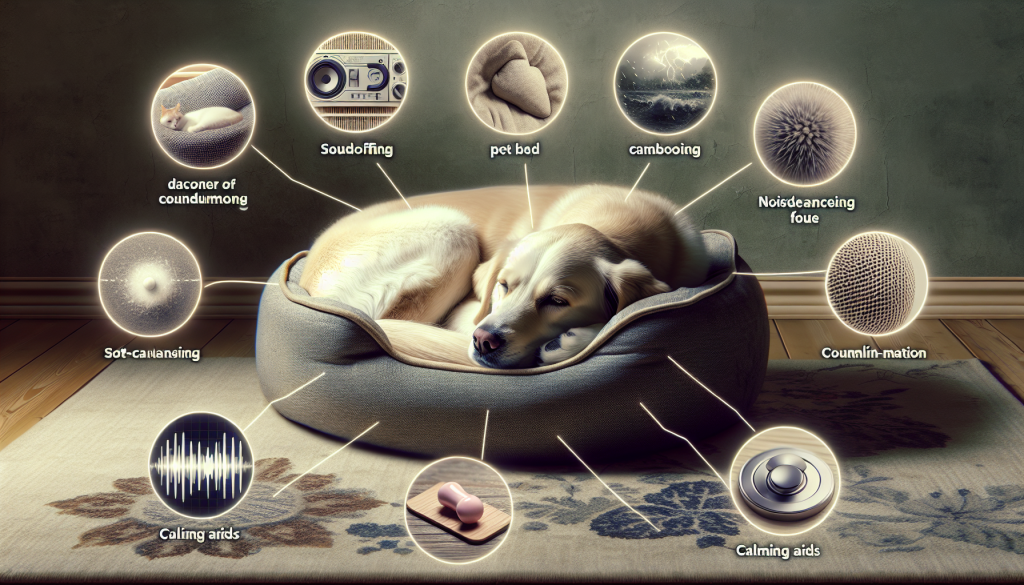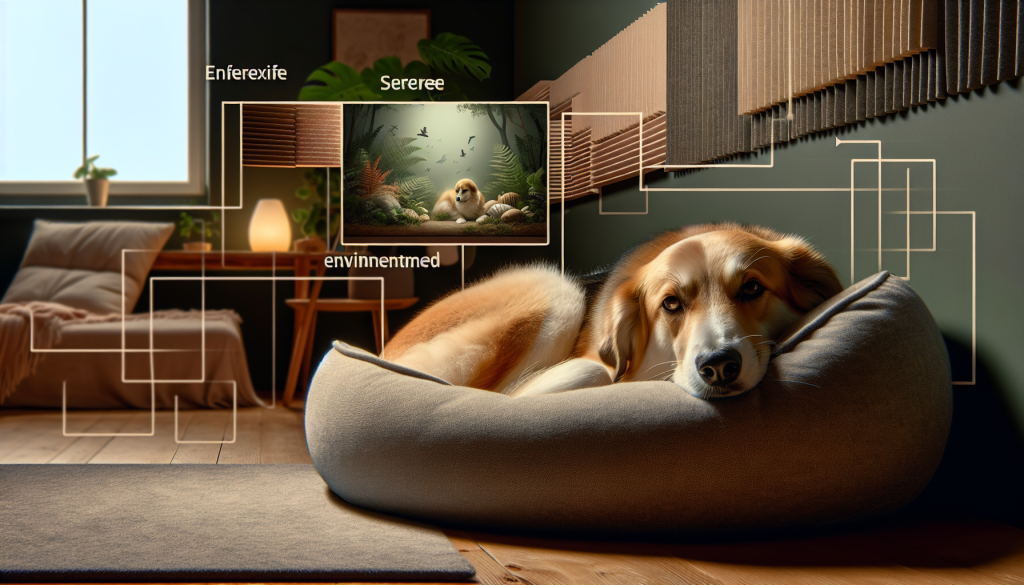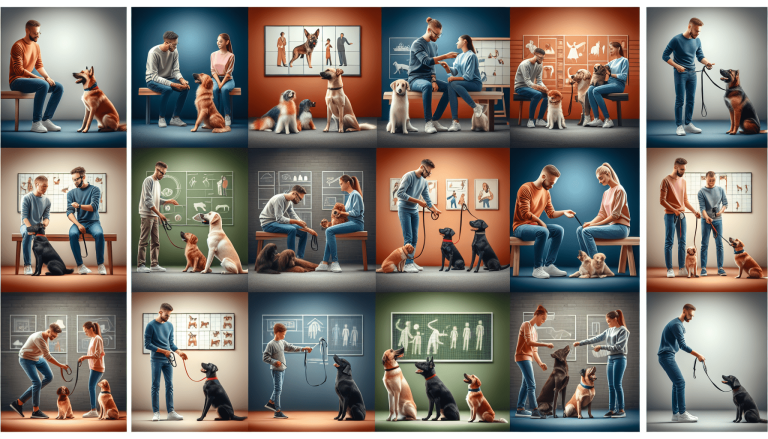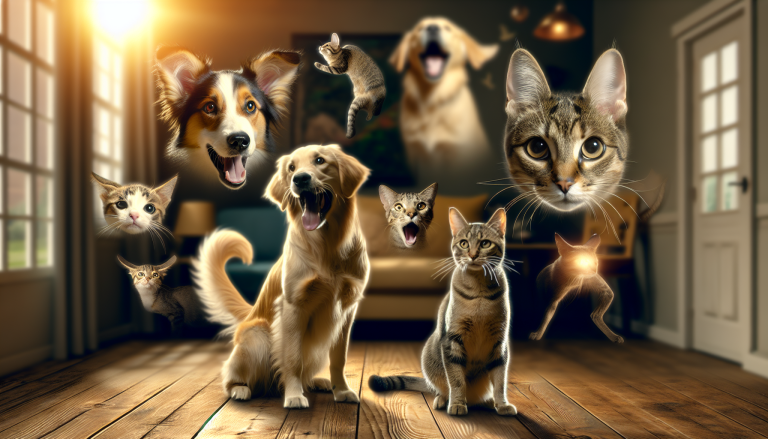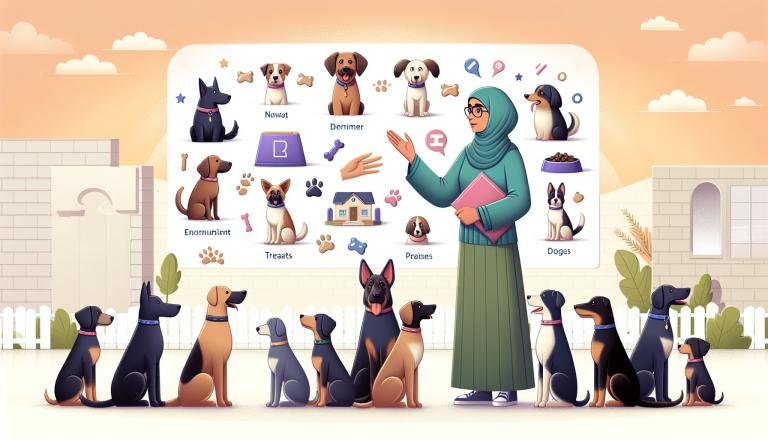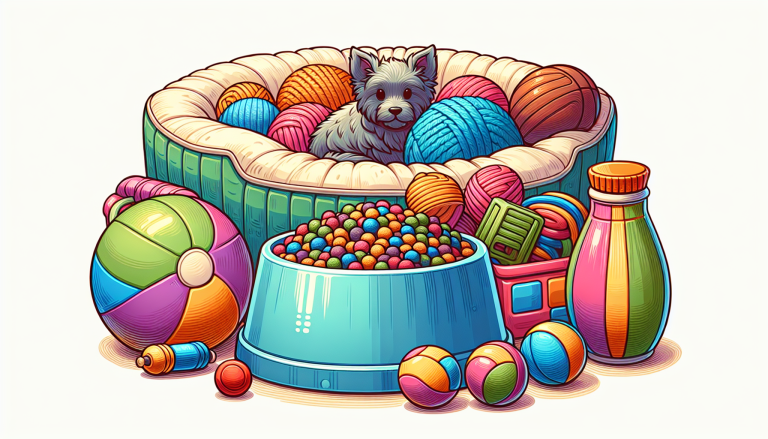Imagine the fear and anxiety your furry friend experiences during thunderstorms and fireworks. The booming noises and bright flashes can send them into a panic, causing distress for both you and your pet. But fear not, there are simple and effective strategies you can employ to keep your pet calm during these chaotic times. From creating a safe and comfortable environment to providing distractions and soothing techniques, this article will guide you on how to ensure your pet’s peace of mind during thunderstorms and fireworks. So, grab your pet’s favorite blanket and let’s embark on a journey towards a calmer and happier companion.
Table of Contents
ToggleUnderstanding Your Pet’s Anxiety
Having a pet with anxiety can be a challenging experience. As a responsible pet owner, it is essential to understand the signs and causes of anxiety in order to provide the best care and support for your furry friend. Recognizing the signs of anxiety and understanding its underlying causes are crucial steps in helping your pet overcome their fears and live a happier, more peaceful life.
Recognizing signs of anxiety
Anxiety in pets can manifest in various ways, and it’s important to be able to recognize these signs. Common signs of anxiety in pets include excessive pacing or restlessness, trembling, panting, excessive grooming, hiding or seeking out constant human contact, decreased appetite, and aggressive behavior. By being familiar with these signs, you can quickly identify when your pet is feeling anxious and take appropriate measures to alleviate their distress.
Understanding causes of anxiety
Pets can experience anxiety due to a variety of reasons. Some common causes include loud noises, such as thunderstorms or fireworks, separation anxiety, changes in routine or environment, past traumatic experiences, and medical conditions. Understanding the root cause of your pet’s anxiety will help you address it more effectively and provide the necessary support to help them cope with their fears.
Creating a Safe Space for Your Pet
Creating a safe and secure environment is key to helping your pet manage their anxiety. By providing a designated space where they can feel protected and comfortable, you can greatly reduce their stress levels and help them feel more at ease.
Choosing a quiet and secure area
When creating a safe space for your pet, it is important to choose an area in your home that is quiet and away from high-traffic areas. This could be a spare room, a corner of a quiet living room, or even a walk-in closet. The key is to find a space where your pet will not be disturbed or feel overwhelmed by excessive noise or activity.
Providing comfortable bedding
In addition to choosing the right location, it is essential to provide your pet with comfortable bedding in their safe space. This will give them a cozy and secure place to retreat to when they are feeling anxious. Consider providing soft blankets, pillows, or even a comfortable pet bed to help create a relaxing environment for your furry friend.
Using a crate or den
Many pets find comfort and security in enclosed spaces like crates or dens. Providing a crate or den in your pet’s safe space can give them a sense of security and help them feel protected during moments of anxiety. Make sure the crate or den is appropriately sized for your pet and filled with their favorite toys or blankets to make it a welcoming and comforting space.
Covering windows
One of the common triggers for pet anxiety is exposure to external stimuli, such as loud noises or sudden movements outside the window. To minimize these triggers, consider covering the windows in your pet’s safe space with curtains or blinds. This will help block out excessive light, noise, and distractions, creating a more peaceful and calming environment for your pet.
Minimizing Exposure to Loud Noises
Loud noises, such as thunderstorms or fireworks, are common triggers for pet anxiety. Minimizing your pet’s exposure to these loud noises is an important step in helping them remain calm and relaxed.
Closing windows and doors
When you know that loud noises are likely to occur, such as during a thunderstorm or fireworks display, ensure all windows and doors in your home are securely closed. This will help reduce the level of noise entering your pet’s safe space and create a quieter environment for them to retreat to.
Turning on the TV or music
Turning on the TV or playing soothing music at a moderate volume can help drown out the sounds of loud noises from outside. Choose calming and relaxing music that your pet enjoys, as this can have a soothing effect and help divert their attention away from the loud noises.
Using white noise machines
Another effective way to minimize the impact of loud noises on your pet is by using white noise machines. These devices emit a continuous and consistent sound that can help mask sudden bursts of noise and create a more peaceful atmosphere. Place the white noise machine near your pet’s safe space to provide them with a constant source of soothing background noise.
Natural Remedies and Medications
Supplementing your pet’s anxiety management plan with natural remedies or medications can provide them with additional support during times of heightened anxiety. However, it is important to consult with a veterinarian before introducing any new treatments.
Consulting with a veterinarian
Before considering any natural remedies or medications, it is crucial to consult with your veterinarian. They will be able to assess your pet’s specific needs, recommend appropriate options, and ensure that there are no underlying medical conditions that need to be addressed.
Exploring natural calming options
There are various natural calming options available that can help alleviate your pet’s anxiety. These include herbal supplements, such as chamomile or valerian root, which have calming properties. Additionally, pheromone diffusers, such as Feliway for cats or Adaptil for dogs, release synthetic pheromones that mimic the calming effect of a mother’s natural pheromones, helping to reduce anxiety and stress.
Considering anxiety medications
In more severe cases of pet anxiety, prescribed medications may be necessary. Anxiety medications can help regulate your pet’s brain chemistry and reduce anxiety symptoms. However, it is essential to work closely with your veterinarian when considering medication options, as dosage and duration of treatment may vary based on your pet’s needs.
Desensitization and Counterconditioning
Desensitization and counterconditioning are behavioral techniques that can help your pet overcome their fears and anxieties over time. These techniques involve gradual exposure to the anxiety-inducing stimulus in a controlled and positive manner.
Gradually exposing your pet to loud noises
With desensitization, you expose your pet to the source of their anxiety, such as loud noises, in a controlled and systematic way. Start by playing recordings of the noises at a low volume while your pet is in their safe space. Over time, gradually increase the volume and duration of exposure, always making sure your pet remains calm and comfortable. The goal is to help them become accustomed to the noises and develop a positive association with them.
Reward-based training
Counterconditioning involves pairing the anxiety-inducing stimulus with something positive and rewarding for your pet. For example, if your pet is anxious around thunderstorms, reward them with treats, praise, or playtime whenever a storm occurs. This positive reinforcement helps your pet associate the previously anxiety-inducing stimulus with something enjoyable, gradually reducing their anxiety response.
Seeking professional help
Desensitization and counterconditioning can be complex techniques that require expertise and guidance. If you find that your pet’s anxiety is not improving or is worsening despite your efforts, consider seeking professional help from a certified animal behaviorist or a qualified trainer. They will assess your pet’s specific needs and develop a tailored behavior modification plan to address their anxiety effectively.
Behavior Modification Techniques
Behavior modification techniques, often used in conjunction with desensitization and counterconditioning, can help redirect your pet’s attention and encourage positive behaviors.
Redirecting attention with toys and treats
When your pet starts to show signs of anxiety, redirect their attention to something positive, such as a favorite toy or treat. This can help distract them from their anxious thoughts and shift their focus onto something enjoyable.
Positive reinforcement training
Positive reinforcement training involves rewarding your pet for desirable behaviors. By using treats, praise, and affection, you can reinforce positive behaviors and encourage your pet to repeat them. This helps to build confidence and reduce anxiety in your furry friend.
Thundershirt and anxiety wraps
Thundershirts and anxiety wraps are specially designed garments that apply gentle pressure to your pet’s body. This pressure has a calming effect and can help relieve anxiety in many pets. These garments work similarly to swaddling a baby and can provide a sense of security and comfort to your pet during times of stress.
Soothing Techniques and Strategies
In addition to behavior modification techniques, there are various soothing techniques and strategies that can help your pet relax and feel more at ease.
Physical touch and massage
Physical touch and massage can provide tremendous comfort to an anxious pet. Taking the time to stroke, pet, or gently massage your pet can release endorphins and help reduce their anxiety levels. Experiment with different techniques and observe how your pet responds to find what works best for them.
Calming music and aromatherapy
Certain types of music, such as classical or instrumental pieces, can have a calming effect on pets. Playing soft, soothing music in your pet’s safe space can help create a serene atmosphere and promote relaxation. Additionally, the use of aromatherapy with pet-safe essential oils, such as lavender or chamomile, can have a soothing effect on your furry friend.
Distraction with interactive toys
Interactive toys that stimulate your pet’s mind and keep them mentally engaged can be beneficial in managing anxiety. Puzzle toys, treat-dispensing toys, or toys that require problem-solving can divert your pet’s attention away from their anxiety and provide them with a stimulating and enjoyable activity.
Professional Help and Expert Advice
In some instances, professional help may be necessary to address your pet’s anxiety effectively. Certified animal behaviorists and veterinarians with expertise in behavior modification can provide valuable guidance and support.
Working with a professional animal behaviorist
A professional animal behaviorist will conduct a thorough assessment of your pet’s anxiety and develop a personalized behavior modification plan. They will guide you through the various techniques and strategies to address your pet’s specific needs and ensure long-term success in managing their anxiety.
Seeking guidance from a veterinarian
Consulting with a veterinarian is always recommended when dealing with pet anxiety. They can rule out any underlying medical conditions that may be contributing to your pet’s anxiety and provide appropriate treatment options or medication if needed. Your veterinarian can also work in conjunction with a behaviorist to provide comprehensive care for your pet.
Preparing for Thunderstorms and Fireworks
Thunderstorms and fireworks are commonly anxiety-inducing events for pets. Taking proactive steps to prepare for these situations can help minimize your pet’s stress and anxiety.
Checking weather forecasts
Keeping an eye on weather forecasts can help you anticipate upcoming thunderstorms. This allows you to take necessary precautions and create a calm and safe environment for your pet ahead of time.
Planning ahead for fireworks displays
Firework displays, especially during celebratory events, can be particularly distressing for pets. Research local firework displays and plan accordingly. Ensure your pet is in a secure location, preferably with you, during the fireworks to provide the comfort, reassurance, and security they need.
Not leaving your pet alone
During thunderstorms or fireworks, it is essential to stay with your pet and provide comfort and reassurance. Leaving them alone can cause them to feel even more anxious and fearful. Your presence and support can go a long way in helping them cope with these stressful situations.
Monitoring and Assessing Your Pet’s Progress
Managing your pet’s anxiety is an ongoing process, and it is important to monitor their progress and make adjustments as needed.
Keeping a record of behaviors
Keeping a record of your pet’s behaviors, including the frequency and severity of their anxiety symptoms, can help you track their progress over time. This record will also be valuable when discussing your pet’s anxiety with your veterinarian or behaviorist, as it provides them with valuable insights into your pet’s specific triggers and responses.
Adjusting strategies as needed
Every pet is unique and may respond differently to various strategies and techniques. If you find that a particular approach is not yielding the desired results, be flexible and willing to adjust your approach. Experiment with different techniques and consult with professionals for guidance to find the best strategies for your pet’s individual needs.
Being patient and persistent
Managing pet anxiety is not a quick fix but rather a gradual process that requires patience and persistence. Remember that each step you take towards helping your pet feel more secure and relaxed is a step in the right direction. With consistent effort and a supportive environment, your furry friend can overcome their anxiety and lead a happier, more peaceful life.
In conclusion, understanding and managing your pet’s anxiety requires patience, understanding, and a holistic approach. By recognizing the signs, addressing the underlying causes, creating a safe space, minimizing exposure to loud noises, exploring natural remedies and medications, utilizing behavior modification techniques, implementing soothing techniques and strategies, seeking professional help when needed, preparing for thunderstorms and fireworks, and monitoring your pet’s progress, you can successfully help your pet overcome their anxiety and provide them with the peace and comfort they deserve. Remember, you are their trusted companion, and through your love and support, you can make a world of difference in their well-being.

